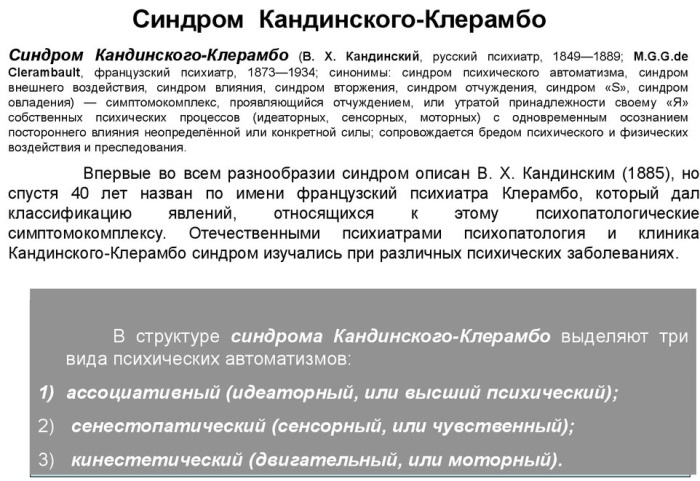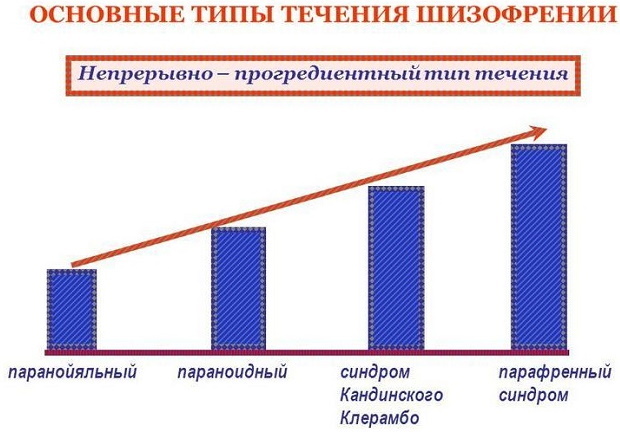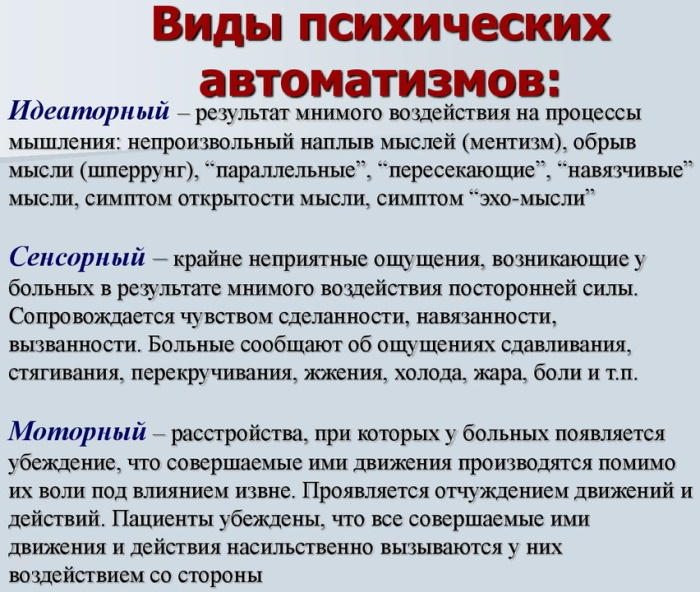Among the many mental disorders that psychiatry treats, there are a number of hallucinatory-paranoid episodes varying degrees of severity.
Among the most severe deviations in the work of the psyche include the Kandinsky-Clerambo syndrome, which is more often called the syndrome of mental automatism. This condition, concomitant with a number of diseases, is characterized by a loss of control over emotions, feelings, thoughts, as well as the appearance of delusional ideas along with hallucinations.
Record content:
-
1 General information
- 1.1 Review of reasons
- 1.2 Risk factors
-
2 Symptoms
- 2.1 Psychic automatisms
- 2.2 Pseudohallucinations
- 3 Development stages
-
4 Classification and characteristics
- 4.1 Attributes of associative type automatisms
- 4.2 Features of the touch variety
- 4.3 Manifestations of motor-type automatisms
- 5 Complications
-
6 Treatment
-
6.1 Traditional treatment
- 6.1.1 Herbal treatment
-
6.1 Traditional treatment
- 7 Video about Kandinsky-Clerambeau syndrome
General information
Kandinsky-Clerambeau syndrome is a paranoid-hallucinatory type and is a severe type of psychotic disorder with personality transformation. A patient suffering from a similar disease, there are signs of obsessive states, as if someone outside was manipulating his psyche.
Among the complaints there are complaints about the existence of a certain subject or force that controls the patient's thoughts and requires his unquestioning obedience. As a result, the patient does not consider himself responsible for his own actions, actions, thoughts.
The rooting of unnatural behavior (mental automatism) is accompanied by hallucinations with the subsequent development of paranoia, turns into alienation of the personality. Against the background of the progression of the mastery syndrome, the emergence of other mental problems is not excluded.
The first doctor to describe in detail the symptom complex of a pathological disorder was the Russian psychiatrist V. NS. Kandinsky. The scientist was engaged in the study of automatisms, the results of his work were published in 1880. Almost 40 years later, the French psychiatrist de Clerambault, who was studying the same problem, proposed a classification of the complex of symptoms recorded by Kandinsky.
As a result, mental illness was named after two scientists who studied pathology comprehensively.
Patients with schizophrenia are more likely to suffer from the syndrome of alienation or exposure (up to 60%); in this case, one should not expect comforting forecasts. Both doctors, after whom the disorder is named, suffered from its symptoms, and in their studies they described their own observations. The death of Kandinsky, like Clerambault, was the result of suicide.
Review of reasons
The main cause of the pathological condition is considered to be schizophrenia. Mental automatisms can also accompany the pre-manifest period with subsequent complication in the course of the development of pathology. High-risk patients include people with an unstable psyche, suffering from far-fetched fears and anxieties, and frequent depression.
The Kandinsky-Clerambault syndrome is an obsessive state of directing one's own consciousness from the outside. In rare cases, signs of automatism can also be observed with other mental problems.
| Type of psychosis | Features of the influence on the psyche |
| Organic | An obsessive state of automatic control from the outside is typical for epilepsy patients who have suffered from traumatic brain injury. Automatisms are observed in persons with impaired blood circulation in the brain, as well as in the presence of neoplasms in it. |
| Intoxication | A complex of hallucinatory-delusional manifestations is usually observed in people with alcohol poisoning, abuse of psychostimulant drugs. The duration of frequent intoxications threatens the development of schizophrenia with the active development of the Kandinsky-Clerambo syndrome. |
| Infectious | Infectious psychoses can appear in the initial and acute phase of the disease, accompanied by anxious and delusional symptoms. The introduction of a pathogen into the brain tissue turns into the translation of hallucinations. As you recover, your productive symptoms subside. |
Treatment of aggravated forms of Kandinsky-Clerambo syndrome (paranoid, schizoid) should take place in a specialized clinic. To recognize psychosis or schizophrenia, a number of special tests are required.
In addition, it is important to differentiate the syndrome from the state of the hallucinatory-delusional type (GBS), since the disorders have similar symptoms. The main difference between GBS is true hallucinations, not accompanied by personality alienation.
Risk factors
Among the factors that can cause the appearance of a mental disorder, you can include such addictions as alcoholic, toxic, narcotic. The start of the development of the Kandinsky-Clerambault syndrome can be given by a traumatic brain injury, which caused cerebral hypoxia. In this situation, the mental disorder becomes a defensive reaction to traumatic actions.
Signs of automatisms are characteristic of the post-stroke period; they can also be the result of a tumor process or cerebral hemorrhage.
Paranoid delusions with hallucinations are characteristic of Wilson's disease, which progresses due to the accumulation of copper in the body. With an incorrect distribution of the element among the organs (liver, kidneys, brain), the process of irreversible changes in them starts. However, it happens that the causes of automatisms are genetically determined.
Symptoms
The Kandinsky-Clerambeau syndrome is the result of psychotic disorders associated with disautomation of the processes that provide emotional reflexes and the ability to cognize. The list of mental disorders over time is replenished with signs of pathological reflexivity, which ultimately leads to the feeling of someone being guided by one's own thoughts and actions.
A person with a sick mentality suffers from depersonalization, separation of thoughts and feelings. The whole complex of symptoms inherent in pathology can be divided into two groups of manifestations - automatism and pseudo-hallucinations.
Psychic automatisms
Such a state is characterized by a feeling of imposition of actions, suggestion of thoughts along with emotions. According to the patient's conviction, his body and mind are under the influence of another person or an entity that affects him energetically.
A person loses a sense of individuality, considering his behavior as the result of outside manipulation, which deprives him of the ability to control his own mental processes.
According to the attitude adopted in psychiatry, external influences are of three types:
- Ideatorial ones are associated with thought control - open thoughts, sound echoing, are invested or taken away by someone, float in a wave (mentism), break off suddenly (sperrung).
- Sensory influences affect the senses of taste and smell, a range of tactile sensations, which leads to the appearance of pseudohallucinations, the development of senestopathy (a painful feeling, not supported by objective reasons).
- The motor type of automatisms is manifested by the patient's conviction that an external force directs his actions and movements. It suppresses the patient's will, controls the movements of his limbs, as well as the ability to move the tongue.
 The process of development of mental automatisms in Kandinsky-Clerambeau syndrome is phased. Usually, ideatorial (associative) episodes develop first, they are replaced by sensory (senestopathic) episodes, which ultimately leads to complaints about the appearance of motor (kinestatic) types of exposure.
The process of development of mental automatisms in Kandinsky-Clerambeau syndrome is phased. Usually, ideatorial (associative) episodes develop first, they are replaced by sensory (senestopathic) episodes, which ultimately leads to complaints about the appearance of motor (kinestatic) types of exposure.
Pseudohallucinations
At different stages of life development (learning to walk, talking and reading, development of thinking), all processes are honed and performed automatically, consciousness in this case does not control them.
With the emergence of automatisms, one's own mental attitudes, worked out over the years, are deactivated and already require consciousness to control them. As a result, a person perceives his activity as alien or imposed by someone.
The syndrome, named after two medical researchers, Kandinsky and Clerambault, also manifests itself as hallucinations. On the basis of delirium of influence, images appear in consciousness that do not correspond to real objects, but the patient considers these pictures to be real.
The appearance of pseudo-hallucinations should not be considered fantasies, because for the patient the images are physically stable, he sees them in detail and vividly without the application of volitional efforts. However, unlike fantasies, it is impossible to stop the transmission of a pseudo-image by the power of will, and the person himself unquestioningly believes in the true reality of the hallucinatory plot.
Pseudo-hallucinations can be visual (people's faces, panoramic pictures), as well as auditory (noises, phrases, words). The most common variant is auditory, which patients call "voices." Such mental episodes are most characteristic of schizophrenia.
Development stages
The Kandinsky-Clerambo delusional hallucinatory syndrome usually develops in one of two scenarios:
- in the case of the delusional variant, mental automatisms dominate in combination with delusional symptoms, but with an extremely rare occurrence of hallucinations;
- with the hallucinatory type, pseudo-hallucinations prevail, automatisms with signs of delusional phenomena are absent or completely minimal.
Taking into account the nature of the course, the pathological state of the psyche progresses in stages.

| Stage of development | Overview of clinical signs |
| Sharp | The phase of increasing symptoms lasts from several days to 2-3 months, characterized by the rage of manifestations. The patient's activity increases, reaching aggression, accompanied by irritability. Emotions are chaotic with a frequent change of delusional fantasies, increased speech and motor excitability, the appearance of fragmentary or paradoxical complaints. |
| Chronic | The process of chronicity lasts for years, and the clinical picture can be varied, but with a gradual increase in symptoms. During this period, automatisms become more complicated - sensory and motor influences are added to associative ones. Delirium becomes systematized, takes on a specific direction (people, situations), but the symptoms are not pronounced. |
It is important to note that the spectrum of the main signs of the chronic course of the Kandinsky-Clerambault syndrome is difficult to diagnose precisely because of the blurred episodic picture. Therefore, in the acute phase, it is necessary to start treatment with sedatives as early as possible in order to avoid the onset of the chronic phase. Then the patient will withdraw into himself, will hide his subordination to "outside influence".
Classification and characteristics
The Kandinsky-Clerambeau syndrome is a complex pathology, the general picture of which is usually classified in psychology into three types. Moreover, each type of alienation syndrome is characterized by certain clinical manifestations of automatisms.
Attributes of associative type automatisms
With this type of pathological condition, the thinking process is disturbed, the patient feels interference in his own thoughts and manifestations of personal emotions.
The main symptoms of psychotic disorder include:
- the presence of auditory hallucinations (sounding thoughts, voices in the head);
- lack of control over their own behavior, blurred memories;
- a feeling of openness of thoughts known to others and sounding an echo.
The patient suffers from obsessions that undermine the stability of the emotional sphere; he justifies the signs of a change in mood by someone else's influence on the psyche. The feeling of obsession with thoughts eventually turns into the patient's conviction that he knows and hears what other people think about.
The syndrome of the associative type is characterized by a feeling of alienation from one's own inferences, a feeling of being a passive observer of one's actions.
Features of the touch variety
This most commonly diagnosed type of automatism in Kandinsky-Clerambault syndrome is manifested by external sensations that are not in reality. The patient explains the effects on the skin and internal organs by the influence of fantastic entities and phenomena in the form of sorcerers, magicians, aliens, cosmic rays.
Symptoms of senestopathic episodes include:
- sensations of heat or cold, burning, tingling on all skin integuments of the body, squeezing of internal organs;
- complaints of urinary retention, fecal incontinence, a state of frequent sexual arousal, causeless pain;
- the facts of the appearance of sensual hallucinations of colossal proportions and fantastic content.
In the opinion of a person suffering from this type of mental pathology, his condition is controlled by outsiders or external forces that are in contact with him mentally. For all his inadequate actions, the patient blames these external forces, hostile to him. Therapy for such a disorder is considered one of the most difficult.
Manifestations of motor-type automatisms
The range of kinesthetic sensations is reflected in the area of motor functions.
The feeling of controlling the body from the outside is signaled by characteristic symptoms:
- stiffness of movements, unnatural facial expressions and gestures;
- a chanted speech that is difficult to understand over time;
- a change in the style of gait, behavior.
The patient is convinced that all his actions and movements are directed by someone else's will, and to those around him, his behavior seems unnatural due to unnatural movements. The main feature of motor automatisms is considered to be interrupted speech, when it is difficult to open the mouth and turn the tongue. The patient explains the reason for the difficulties by the influence of someone else's will on him.
Complications
Kandinsky-Clerambeau syndrome is a complex disorder of mental and motor functions, its rapid progression threatens with depersonalization. Signs of megalomania, the patient's belief in his ability to mentally control other people, influencing their feelings and physical activity, most often accompanies schizophrenia.
The danger of the situation is indicated by the complication of automatisms and the increase in their frequency. Progress ends in severe personality disorder with loss of self-awareness and a sinking into a state of alienation.
With the dominance of the delusional-hallucinatory variety of the syndrome, the main danger is depersonalization of the delusional type. In this case, the patient is convinced of the metamorphosis that happened to him, which turned him into a creature of a different type - an alien, a recruited agent, the shadow of another person. Pathology is difficult to treat, quickly becomes a mental defect.
Treatment
Patients suffering from Kandinsky-Clerambault syndrome are treated by a psychiatrist in a specialized clinic. Complex therapy is focused on stopping the bright signs of the acute period with the elimination, as far as possible, of the causes of the development of automatisms.
Drug therapy is prescribed to reduce the productivity of the symptoms of the disorder:
- delusional manifestations, together with hallucinations and psychomotor agitation, are removed with antipsychotics, which inhibit the processes of nervous activity;
- to stabilize sleep, as well as the emotional background, it is recommended to take antidepressants, tranquilizers, sedative drugs.
With the onset of the stage of recovery, when the patient becomes aware of what is happening to him, the help of psychotherapeutic techniques will be required. An experienced therapist can help a recovering person cope with confusion, feelings of depression and anxiety. Thanks to effective methods of therapy, it is possible to restore the lost psychological attitudes, life values.
Traditional treatment
Traditional medicine is not an independent treatment for Kandinsky-Clerambo syndrome. This is only supportive therapy in addition to the course prescribed by the doctor. On the advice of Tibetan healers, the patient's body can be rubbed with olive oil, a portion of which has been aged for a year in the ground at a depth of 1.5 meters. Particular attention should be paid to rubbing the head and neck.
Herbal treatment
It is not forbidden to supplement the complex of therapeutic measures helping to restore the lost psychological health with the intake of medicinal herbs. Among the plants for herbal medicine, peony is considered the most effective; tincture from its roots soothes the nervous system well.
A decoction of oregano will help to cope with hand tremors, which should be taken within a month. To get rid of insomnia, use a herbal mixture (oregano, hop cones, thyme), from which a medicinal infusion is prepared. For rubbing the temples, oil based on fragrant reseda is suitable.
With the early treatment of the syndrome described in detail by Kandinsky and Clerambo, a favorable prognosis can be expected. This is especially true in the case of a predominance of the hallucinatory-delusional component, then intensive therapy helps to reduce the severity of symptoms.
Further, during the rehabilitation period, the patient must follow a diet with a high copper content, not give up physical activity, being under the constant supervision of a psychiatrist.
Video about Kandinsky-Clerambeau syndrome
About Kandinsky-Clerambeau syndrome:



